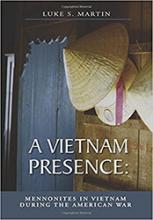As the government of South Vietnam teetered on the brink of collapse in the spring of 1975, Mennonite missionaries living in Saigon agonized over whether to leave or stay. In the end, mothers and children left the country, and only a few men stayed to experience the communist takeover.
Luke S. Martin intended to return to Saigon after a short visit to Bangkok to meet with a representative of Mennonite Central Committee (MCC) and to see his family, but the end came sooner than expected, and returning in time was not possible. He believed that staying through the chaos of revolution was important so that the fledgling Mennonite church in Vietnam would not feel abandoned.
Martin has written a comprehensive and detailed history of the work done by Mennonites in Vietnam between 1954 and 1975. His research is thorough and he quotes from many letters and other documents. The maps and photos are helpful in telling the story.
The roots of the Mennonite church in Vietnam go back to the 1950s, when MCC began its relief work there (1954) and when the first Mennonite missionaries from North America arrived (1956). Luke and Mary Martin served in Vietnam from 1962 until 1975, mostly working as missionaries, but Luke also supervised the work of MCC during some of those years.
MCC in Vietnam had many unsettling moments through the war years, as it struggled to know how much to cooperate with the U.S. military. In the early years, it often helped distribute food for the U.S. Agency for International Development (USAID) and it felt natural to work with the army’s medical staff. As the U.S. increased its military presence through the 1960s, MCC workers were more and more uncomfortable accepting assistance from, or being identified with, U.S. troops.
The Christian and Missionary Alliance denomination had been working at spreading Christianity in Vietnam since 1893, and early Mennonite missionaries cooperated with the Alliance mission programs and the broader Protestant church in Vietnam.
As U.S. military intervention increased, Mennonites grew more concerned about the American patriotism expressed by some missionaries. Seeing how the Vietnamese people were suffering due to the ongoing war, Mennonites tried to distance themselves from U.S. policy.
One Sunday morning in 1966, Doris Janzen Longacre was filling in as the guest organist at a worship service at which many Americans were present. She was so repulsed by the glorification of American nationalism and militarism that she walked out after the second verse of a hymn.
The MCC and mission workers in Vietnam also helped to change the attitudes of Mennonites in North America. Until the mid-20th century, Mennonites had been taught to pray for the government but not to interfere, but in the 1960s, as Mennonites in North America heard the passionate anti-war protests of those who saw the effects of the war first-hand, they began to speak out about government policy.
A Vietnam Presence is not difficult to read, except that the many details are almost overwhelming. This is a large book both in the number of pages and the size of the pages. Anyone who shared some of Martin’s experiences will not find the exhaustive detail oppressive, but this is not a book to read in one sitting.
Most compelling are Martin’s honest reflections about the challenges of serving God with integrity while U.S. bombs were dropping all over Vietnam. Serving as a Mennonite missionary in that context required great courage.
See also the full list of the Spring 2017 Books and Resources.



Add new comment
Canadian Mennonite invites comments and encourages constructive discussion about our content. Actual full names (first and last) are required. Comments are moderated and may be edited. They will not appear online until approved and will be posted during business hours. Some comments may be reproduced in print.